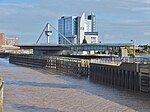Arctic Corsair
1960 shipsFishing vessels of the United KingdomIMO numbersMuseum ships in the United KingdomMuseums established in 1999 ... and 3 more
Museums in Kingston upon HullShips and vessels on the National Register of Historic VesselsUse British English from August 2015

The Arctic Corsair (H320) is a deep-sea trawler, built in 1960, that was converted to a museum ship in 1999. She is temporarily berthed at Alexandra Dock in Kingston upon Hull, England, pending completion of a new permanent location in the city's Museums Quarter. Exhibits and guides aboard the boat tell the story of Hull's deep-sea fishing industry.
Excerpt from the Wikipedia article Arctic Corsair (License: CC BY-SA 3.0, Authors, Images).Arctic Corsair
Tower Street, Hull Old Town
Geographical coordinates (GPS) Address Nearby Places Show on map
Geographical coordinates (GPS)
| Latitude | Longitude |
|---|---|
| N 53.742777777778 ° | E -0.32777777777778 ° |
Address
Tower Street
Tower Street
HU9 1TY Hull, Old Town
England, United Kingdom
Open on Google Maps










